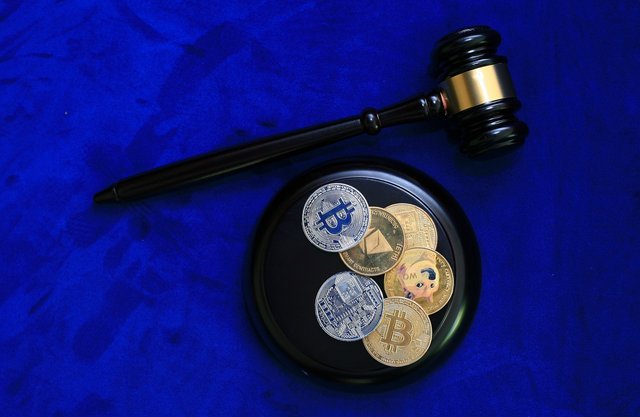Crypto decentralization

Greetings to you my dear friend steemian of the steem4bloggers community. I hope we are okay. I'm excited to be participating on this amazing contest brought to us. Crypto topics are something captivating to me that I can't keep quiet but say what I have in mind.
Decentralization in cryptocurrency refers to the distribution of power and control across a network of computers, rather than being concentrated in the hands of a single entity or authority like the traditional system (banks). This means that no single person or organization can control or manipulate the network, ensuring its security, resilience, and fairness.
How do decentralized network achieve consensus? |
|---|
Consensus is a fundamental concept in decentralized networks, ensuring that all nodes agree on the state of the system. This is most essential for maintaining the integrity and security of the crypto network.
Here are a few common concepts used to achieve consensus:1• Proof-of-Work (PoW)
Mechanism: Nodes compete to solve complex cryptographic puzzles. The first node to solve the puzzle adds a new block to the blockchain.
Advantages: Highly secure, resistant to censorship and attacks.
Disadvantages: Energy-intensive, can be centralized due to mining pools.
2• Proof-of-Stake (PoS)
Mechanism: Nodes stake their cryptocurrency as collateral. The more a node stakes, the higher its chance of creating the next block.
Advantages: Energy-efficient, can be more decentralized.
Disadvantages: Can be vulnerable to attacks like nothing-at-stake and centralization.
3• Delegated Proof-of-Stake (DPoS)
Mechanism: Users vote for delegates who represent them in the consensus process. Delegates create blocks and earn rewards.
Advantages: Efficient, allows for participation by users who may not have significant holdings.
Disadvantages: Can be less decentralized, as power can be concentrated in the hands of a few delegates.
4• Practical Byzantine Fault Tolerance (PBFT)
Mechanism: Requires a majority of nodes to be honest. A leader is chosen to propose blocks, and other nodes vote on their validity.
Advantages: Fast, efficient, and secure.
Disadvantages: Requires a high number of nodes, can be challenging to scale.
5• Tendermint
Mechanism: A Byzantine Fault Tolerant consensus algorithm designed for blockchain networks. It uses a leader-based approach with a voting mechanism.
Advantages: Fast, efficient, and secure.
Disadvantages: Can be complex to implement and maintain.
The choice of consensus mechanism depends on various factors, including security requirements, scalability needs, and energy efficiency.
How do decentralized network impacts governance of crypto? |
|---|
Decentralized networks, underpinning the majority of cryptocurrencies, have a profound impact on their governance.
Here's a breakdown of how it work.
1• Community-Driven Governance:
Consensus Mechanisms: Decentralized networks often use consensus mechanisms like Proof-of-Work (PoW) or Proof-of-Stake (PoS) that enable community members to participate in validating transactions and securing the network.
Token Voting: Majority of cryptocurrencies allow token holders to vote on proposals for changes to the network, such as protocol upgrades or new features. This strengthen the community to shape the future of the project.
Decentralized Autonomous Organizations (DAOs): DAOs are autonomous entities governed by smart contracts, helping community members to propose, vote on, and execute decisions without the need for central authority.
- Resistance to Censorship:
Immutability: Decentralized networks are designed to be robust to censorship. Once a transaction is recorded on the blockchain, it cannot be tampered or deleted, ensuring that information remains accessible and unchangeable.
Distributed Nature: The distributed nature of decentralized networks makes it difficult for any single entity to control or shut down the entire system.
- Transparency and Accountability:
Public Ledger: All transactions on a decentralized network are recorded on a public ledger, providing transparency and accountability. This makes it easier to track the movement of funds and identify potential fraud activities.
Smart Contracts: these contracts execute themselves with the terms directly written into code. This cancels the need for intermediaries and ensures that agreements are executed automatically and transparently.
- Challenges and Limitations:
Scalability: As decentralized networks grow in size and complexity, they may face scalability challenges, limiting their ability to handle large volumes of transactions more efficiently.
Security: While decentralized networks are generally secure, they are not immune to attacks. Vulnerabilities in the underlying code or consensus mechanisms can be exploited by Internet fraudsters.
Complexity: Decentralized networks can be complex to understand and use, potentially limiting their accessibility to a wider population.
In conclusion, decentralized networks have significantly impacted the governance of cryptocurrencies by contributing to community-driven decision-making, resisting censorship, promoting transparency, and addressing challenges related to scalability, security, and complexity.
I am inviting the following persons to participate with me in this contest. @fombae, @sahmie and @missyleo
Credit to:@rafk


